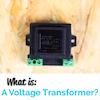What is a Voltage Transformer?
So, what is a voltage transformer? In simple terms, Voltage transformers are a lateral type of instrument transformer. Transformers step down high voltage sources, protecting lower-rated meters and circuits. Transformers feature prominently on a day to day basis, in various electronic appliances, and a majority of these transformers step down. This means they go from a high voltage to a low voltage. For example, 240V to 16V in most HVAC Systems. Whilst this is the most common function of a transformer, they also step up voltage too! However just because it’s doing the opposite reaction, does mean it serves the same purpose. Stepping up is mainly used to diminish the loss of voltage. The most noteworthy appearance would be in transmission lines, where the voltage is extremely high
With all the electricity and voltage flying around it is vital that you remember, Transformers DO NOT generate electricity. Transformers transfer power from one circuit or grid, to another. The transfer occurs via Magnetic Coupling. In the centre of the Transformer, there is a coil (also known as windings). Windings provide a stable route for the magnetic flux radiated throughout the transformer itself.
A transformer is similar to a human heart, in the sense that it has 4 chambers;
Input circuit
Primary is another name for the input circuit. The primary is where the mains electrical power needed to be stepped down, is connected.
Output circuit
The opposite of the input circuit! The output is where the voltage is released into an appliance of some sort. As mentioned earlier, dependent on the voltage, the incoming electricity is either strengthened or weakened.
Windings
There are 2 windings within a transformer. A primary, and a secondary. The coil which sucks up all the power is the primary, whereas the secondary coil delivers the converted payload. In order to prevent the manifestation of Flux, the primary and secondary coils separate into multiple smaller coils.
Core
The core of the transformer acts as a safe route for any flux generated to pass. The core consists of a high volume of thin steel strips. The strips allow heat to pass quicker and cool the core more effectively.
However, there isn’t just one type of core. There are 2! The Shell Type, and Core Type.
The major difference between these types lies within the way the coils interact with the steel core. When it comes to the Shell type, the coils surround the steel core – somewhat like a snail! Core type coils wrap around the steel itself.
Potential Transformers is another name for Voltage Transformers. There are actually 3 types of Potential Transformers; Optical, Capacitor and Electromagnetic. Optical voltage transformers go by the Faraday effect, spinning polarised light, in materials that use optics. Greater voltages require Capacitor transformers. This is due to the fact that they possess a potential divider. This is because they come at a lower cost than electromagnetic transformers. Most noteworthy, Electromagnetic Transformers as previously spoken about, the steel cores surrounded by coils.
The temperature of your residential air conditioning unit is controlled via a thermostat. HVAC Systems give the thermostat power by a Transformer (step down). By going through the transformer, this regulates the currents and ensures the Voltage is correct. If the voltage is too low, the HVAC systems would not function. However, if the voltage is too high it could fry the system.

